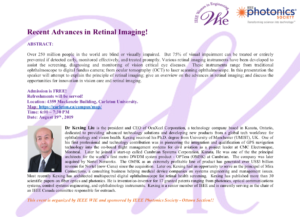Events

The IEEE Reliability Society & Power Electronics Society Joint Ottawa Chapter and PELS Student Chapter are inviting all interested IEEE members and prospective members to celebrate the 1st PELS Day  with a seminar and tour in Solantro’s labs
Â
The Future of Power Electronics: Â
wide bandgap devices and advanced digital power processors
ByÂ
Tanya Gachovska and Chris Winkler
     Â
DATE:
June 20th, 2019
TIME:
  Refreshments, Registration and Networking: 17:00
  Seminar: 17:30 – 18:30;
  Trip: 18:30 19:30
PLACE:
   Solantro Semiconductor Corp.
  146 Colonnade Rd; Suite 200; Ottawa ON, Canada; K2E 7Y1
Abstract
Wide bandgap semiconductors have drawn a lot of attention in power applications due to their superior material properties, such as withstand to high critical electric field so the breakdown voltage is a minimum of 10X higher and thus can be thinner devices because of the 100 times smaller on-resistance than Si. Their significantly smaller conduction and switching losses compared to Si devices enable high-frequency switching leading to size decrease of the overall system. Smart control of wide bandgap devices, by utilizing advanced digital processors, further benefits power application by enabling designs with low parts count, high power density and a low BOM cost. Also, by supporting variable frequency operation and control methodologies, low EMI/RFI and high efficiency can be achieved. Presented will be some benefits of wide bandgap semiconductors and their control with Solantro’s advanced digital power processor (SA4041) for Smart Power Supplies, and other applications.
After the presentation, a tour showing the Smart Grid project together with Solantro’s Power development, operation and testing labs will be conducted. Solantro engineers will be happy to answer questions during the tour.
Admission
Free: Register by email: ottawapels@gmail.com
Since the event is at
Solantro and the space is limited, only people registered for the event will
be admitted.
GNSS
Antennas for Autonomous Vehicles:
What You Need to Know!
Â
Precise
and reliable positioning recently became a critical property of autonomous
vehicles like drones, driverless cars and more. Tallysman Wireless will explain
why the GNSS antenna is the most important component for accurate positioning
and will present the challenges of selecting the appropriate GNSS antenna for
diverse types of autonomous vehicles. Multiple properties of a GNSS antenna
like its phase center variation, ability to reject interferences or multipath
and sensibility to its environment will be analysed and guide lines will be
proposed.
Â
Refreshments will be served!
Location: 4359 Mackenzie Building, Carleton University.
Map: https://carleton.ca/campus/map/
Time: 6:00 – 7:00 PM
Date: July 17th , 2019
Â
BIOGRAPHY:
Julien
Hautcoeur received the M.Sc. degree in radio communication systems and
electronics from the Ecole Polytechnique of the University of Nantes, Nantes,
France, in 2007 and the Ph.D. degree in signal processing and
telecommunications from the Institute of Electronics and Telecommunications of
Rennes 1, Rennes, France, in 2011. In 2011, he was involved in postdoctoral
training at the University of Quebec in Outaouais (UQO), Gatineau, QC, Canada.
His research field was optically transparent antenna systems for telecommunications.
Since 2014 he works at Tallysman Wireless in Ottawa, Canada and specialized in
the design of high performance GNSS antennas and associated electronics.
GPSPlacement

ABSTRACT:
Over 250 million people in the world are blind or visually impaired. But 75% of visual impairment can be treated or entirely prevented if detected early, monitored effectively, and treated promptly. Various retinal imaging instruments have been developed to assist the screening, diagnosing and monitoring of vision critical eye diseases. These instruments range from traditional ophthalmoscope to digital fundus camera; from ocular tomography (OCT) to laser scanning ophthalmoscope. In this presentation the speaker will attempt to explain the principle of retinal imaging; give an overview on the advances in retinal imaging; and discuss the opportunities for innovation in vision care and retinal imaging.
SPEAKER:
Dr Kexing Liu is the president and CEO of OcuXcel Corporation, a technology company based in Kanata, Ontario, dedicated to providing advanced technology solutions and developing new products from a global tech workforce for ophthalmology and vision health. Kexing received his Ph.D. degree from University of Manchester (UMIST), UK. One of his first professional and technology contribution was in pioneering the integration and qualification of GPS navigation technology into the on-board flight management systems for civil aviation as a project leader at CMC Electronique, Montreal. Later he joined a start-up called Cambrian Systems Corporation, Kanata, He was one of the the principal architects for the world’s first metro DWDM system product – OPTera (OM5K) at Cambrian. The company was later acquired by Nortel Networks. The OM5K as an extremely profitable line of product has generated over US$3 billion revenue for Nortel (now Ciena) since the acquisition. Later on, Kexing had an opportunity to serve as the principal of Mira Connections, a consulting business helping medical device companies on systems engineering and management issues. Most recently Kexing has architected multispectral digital ophthalmoscope for retinal health screening. Kexing has published more than 30 scientific papers on fiber optics and photonics. He is inventor/co-inventor for 17 granted patents ranging from photonics, optical communications systems, control systems engineering, and ophthalmology instruments. Kexing is a senior member of IEEE and is currently serving as the chair of an IEEE Canada committee responsible for outreach.
This event is organized by IEEE WIE and sponsored by IEEE Photonics Society – Ottawa Section!!
Kexing
Advanced Optical Sources for Spectrally Efficient Photonic Systems
Liam Barry,
Dublin City University
Â
Abstract
The continuing growth in demand for bandwidth (from residential and business users), necessitates significant research into new advanced technologies that will be employed in future broadband communication systems. Two specific technologies which are becoming increasingly important for future photonic
systems are wavelength tunable lasers and optical frequency combs. Although these topics have been studied for over two decades their significance for the development of future ultra-high capacity photonic systems has only recently been fully understood. Wavelength tunable lasers are currently becoming the
norm in optical communication systems because of their flexibility and ability to work on any wavelength. However, as their operating principles are different to standard single mode lasers they can effect how future systems will operate.
For example as optical transmission systems move towards more coherent transmission (where the data is carried using both the intensity and phase of the optical carrier), the phase noise in these tunable lasers will become increasingly important. Optical frequency combs also have many applications for
future photonics systems, and for telecommunications they can be used to obtain the highest spectral efficiency in optical transmission systems by employing the technology of optical frequency division multiplexing (OFDM) that has been widely employed to increase spectral efficiency in wireless systems. Wavelength tunable lasers and optical frequency combs are thus topics at the leading edge of current photonics systems research, and their detailed understanding promises new applications in all-optical signal processing, optical sensing and metrology, and specifically telecommunications. This talk will focus on the development and characterization of various wavelength tunable lasers and optical frequency combs, and then outline how these sources can be employed for developing optical transmission systems and networks which make the best use of available optical spectrum.
Bio
Liam Barry received his BE (Electronic Engineering) and MEngSc (Optical Communications) from University College Dublin and his PhD from the University of Rennes. His main research interests are: all-optical signal processing, optical pulse generation and characterization, hybrid radio/fibre communication
systems, wavelength tuneable lasers for reconfigurable optical networks, and optical performance monitoring. He has worked as a Research Engineer in the Optical Systems Department of France Telecom’s Research Laboratories (now known as Orange Labs), and a Research Fellow at the Applied Optics Centre in Auckland University. He is currently a Full Professor in the School of Electronic Engineering at Dublin City University, establishing the Radio and Optical Communications Laboratory, and is a Principal Investigator for Science Foundation Ireland. He has published over 500 articles in internationally peer reviewed journals and conferences, holds 9 patents in the area of optoelectronics, and has co-founded two companies in the photonics sector.
Date Wednesday, Oct 30, 2019
Location 359 Terry Fox Drive, Kanata, Ontario
Agenda
    11:30 AM – 12:00 PM: Light Lunch and Networking
    12:00 PM – 1:00 PM : Presentation and Q&A
1:00 PM – 1:30 PM  : Post Presentation Networking
Title of the Talk AI-Powered 5G Networks
& Beyond
Speaker  Hatem Abou-zeidÂ
Summary
5G Networks are anticipated
to transform modern societies by providing an ultra-reliable, high-speed
communications infrastructure that will connect billions of devices including
vehicles, machines, and sensors. Both the complexity of such networks and the
diversity of application requirements will be unprecedented. This mandates
novel, autonomous network configuration and operation that can anticipate and
react to changes in traffic, topology, and interference conditions to ensure
seamless quality of experience and reliability. In this talk I will discuss
AI-driven networking use-cases elaborating on the practical challenges of
industrial deployments. I will then highlight directions where research is
needed to further expedite and facilitate the development of AI-powered
networks.
Biography
Hatem Abou-zeid is a
Senior 5G Systems Designer at Ericsson Canada where he drives research and
system development for 5G radio access networks. Prior to that he held
industrial positions at CISCO Systems and Bell Labs in addition to postdoctoral
and research assistant affiliations at Queen’s University, Canada. His research
focuses on the application of machine learning in 5G networks with particular
emphasis on anticipatory and adaptive algorithms drawing on methods from
reinforcement learning, spatio-temporal forecasting, deep learning and
stochastic optimization. Dr. Abou-zeid is very passionate about developing
strong industry-university collaborations that foster applied, innovative
research, and he leads multiple academic partnerships on intelligence and
analytics in future networks.

